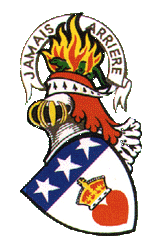   |
|
|
|
|
| ||||||
Pumpherston
This page is a stub - you can help cpmplete it
There are many theories around how Pumpherston became so-called. It
was rumoured that the "pump" or "pumper" came from the oil shale
works, that would have pumped the shale oil into tanks to be
delivered to factories and homes. That theory falls apart as
Pumpherston Castle existed some 250 years before the shale industry
was started (by James "Paraffin" Young, in the late 19th century). A
better theory is that the castle was built by someone called
"Humphrey" and passed to his son. In late 17th century Scotland,
"son of Humphrey" would have been known as "ap Humphrey", which
sounds like "pumphrey", hence Pumphreys-ton or Pumpherston.
Recorded as far back as the 16th century as Over Howden, the Howen estate belonged to the Douglas family of Pumpherston. In 1601 a complaint was made to the Privy Council that "upon the 7th of the said month, William Borthuik.....and others, at nine hours of the morning came to the complenaris landis of Over Howden and there slew two of his horses while ploughing and wounded his ploughmen, so that they dared not labour his lands. The accused, not appearing, are ordered to be denounced His Highness as "rebels".
Near to the farm steading of Nether Craig was the house of Nether Howden, the major portion of which lands, together with Over and Nether Craigs, were, during the present century, incorporated in the one farm of Craigs(1) — more properly called Craigs and Howden. These lands belonged, in 1602, to Joseph Douglas of Pumpherston, by whom they were conveyed to James and Henry Mekill, lawful sons of the late Thomas Mekill in Watterstoun, redeemable for the sum of £400.
After the death of James Douglas, the last laird, the estate passed by purchase to Alexander Hamilton, bailie of Strathbrock (now Uphall), who acquired the various rights of Isobel, Margaret, and Janet Douglas, and Elizabeth Darg, the four heirs-portioners of the deceased James Douglas of Pumpherston, as well as certain other encumbrances affecting the lands, between 1698 and 170L He did not, however, long enjoy his acquisition, but died prior to 30th April 1703, when John Hamilton, his son, was retoured his heir.
Notes: 1. There is also a Craigs in Dumfriesshire which was in Douglas hands in the 19th century - see Douglas of Baads
See also:
Any contributions will be gratefully accepted
| |||||||||||||||||||||||||||
|
The content of this website is a collection of materials gathered from a variety of sources, some of it unedited. The webmaster does not intend to claim authorship, but gives credit to the originators for their work. As work progresses, some of the content may be re-written and presented in a unique format, to which we would then be able to claim ownership. Discussion and contributions from those more knowledgeable is welcome. Last modified: Thursday, 23 January 2025 |